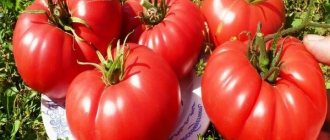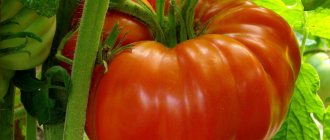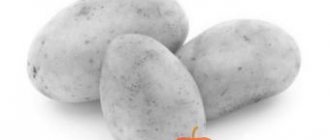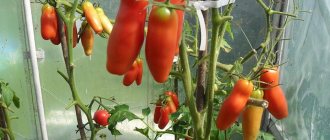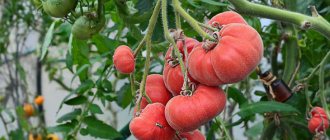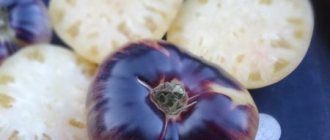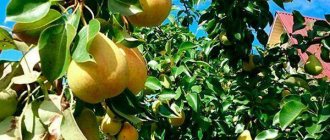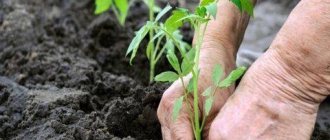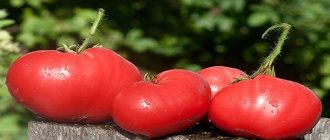» Vegetable growing » Tomatoes » Tomato variety Red Pear
0
1229
Article rating
The Red Pear tomato is deservedly popular and in high demand among gardeners. And this is not surprising, because it is known for its remarkable characteristics: fresh tomatoes have excellent taste, they are also good for heat treatment, the care rules are very simple, which is very convenient for beginners.
- Advantages and disadvantages
- Features of growing tomatoes
- Care
- Reviews from gardeners about the variety
Tomato variety Red Pear
Description and characteristics of the variety
The tomato is indeterminate, 1.6-2 meters high. Ripening time is average - 115-120 days from germination. The stem is medium thick, the internodes are long, the leaves are light green. The variety is intended for cultivation in seasonal greenhouses and open ground. The plant requires shaping, pinching, and obligatory garter.
The inflorescences are simple, appearing after 2-3 leaves. Each produces 8-10 ovaries. The fruits are small, even in shape, weighing 50-80 grams. The skin is bright red, thick, the flesh is dense. Inside are two chambers with an average content of seeds and liquid. The pulp is uniform red in color, dense. The taste is balanced, sweet-sour, tomato.
Black pear
The “Black Pear” tomato is a tall plant: its height varies from 135 to 180 cm. It is mid-season and bears fruit very richly. The fruits of this variety are characterized not only by their pear-shaped shape, but also by their unusual burgundy-brown color. They have a pronounced density, good taste and are not prone to cracking.
These vegetables are mainly used for whole-fruit canning and for adding to salads as a decoration.
These tomatoes will take root in any well-fertilized soil, but it is worth taking into account that they do not like wind and prefer places in the sun. For 1 sq.
No more than 4 plants should be placed per meter. Procedures such as tying, loosening, fertilizing and weeding the soil are mandatory. Watering is carried out only with warm water. With proper care, the yield from 1 sq. meter will reach 5 kg.
Black Pear tomatoes stand out not only for their unusual shape, but also for their dark, almost black color.
All shoots of the Black Pear tomato are removed, with the exception of one - the one that appears under the first brush: you need to form a second stem from it.
Agricultural technology of tomatoes
The rules for growing the variety are standard: removing the shoots, shaping the plants into 2 stems, tying them to stakes or trellises, moderate watering and fertilizing.
Landing
Transferring seedlings to the greenhouse begins in late April or early May, and to open ground - at the end of May or early June. The soil should warm up to a temperature of 16-18 °C. In the first week after planting, the crop is provided with gentle conditions: shaded from the scorching sun and protected from drafts.
Soil preparation begins in the fall. The area is dug up and one 10 liter bucket per 1 m² is added. In spring, the soil is loosened again and fed with humus - 10 liters per 1 m².
Reference. To plant bushes, select an area where white cabbage, cauliflower, peas, beans, parsley, and onions were previously grown.
Holes for seedlings are dug at a depth of 15-20 cm, filled with a concentrated solution of potassium permanganate or boiling water, and 3-5 g of superphosphate are added. The seedlings are moistened abundantly and transferred into holes with a lump of earth. Seedlings in peat pots are planted directly into them. The soil is poured to the level of the lower leaves. This helps the plant take root faster.
Planting pattern – 40x60 cm, 3 bushes per 1 m².
Care
Regularity is important in caring for Red Pear tomatoes. Plants are watered moderately, fed with organic matter and mineral compounds, hilled up to strengthen the root system, loosen the soil and remove weeds.
Mulching the soil with agrofibre, straw, hay, sawdust, and pine needles will help make the maintenance task easier. Mulch inhibits the growth of weeds, prevents the formation of a hard crust on the surface after watering and prevents late blight infection.
Tomatoes are earthed up 10 days after planting, after thoroughly moistening the soil. Repeated hilling is carried out after 14 days.
Water calculation for each tomato bush is 1 liter. Pear-shaped varieties do not tolerate overwatering. Excessive moisture leads to rotting of the rhizomes, and the fruits also begin to deteriorate.
For fertilizing use organic matter and mineral fertilizers (once every 2 weeks):
- The first portion of nitrogenous fertilizers is applied 14 days after planting - 1 liter of mullein, 1 liter of green fertilizers (based on tops and mown grass), 1 liter of ash per 10 liters of water.
- Subsequent feeding is carried out with ready-made mineral compositions every two weeks: “Kemira”, “Rastvorin”, ammophos, nitrophoska, nitroammophos. The dosage and method of use are indicated on the packaging.
The bushes are regularly planted and formed into 2 stems. This technique allows you to obtain a consistently high yield. The lower leaves are regularly plucked off to improve air exchange.
Plants are tied to tall wooden stakes or trellises.
Features of cultivation
The Red Pear variety is grown without seedlings, following the recommendations:
- Tomatoes prefer loose and nutritious soil. The soil is dug up 2-3 weeks before sowing and potassium-phosphorus fertilizers are applied. The area is sprinkled with wood ash at the rate of 2 kg per m².
- The seeds are placed in holes 1.5 cm deep at a distance of 40 cm.
- After sowing, the soil is moistened abundantly with warm, settled water and covered with film or lutrasil.
- After warm weather sets in, the shelter is removed.
- Seedlings are thinned out if necessary and weak shoots are removed.
- Further care includes fertilizing, weeding, watering and loosening. During fruiting, watering is limited to prevent cracking of tomatoes.
- The garter is made when the height reaches 40-50 cm.
Reference. Lutrasil is a modern covering material. Made from polymer threads tightly woven together. Protects plants from sub-zero temperatures, retains heat, and allows moisture and air to pass through perfectly.
Diseases and pests
The Red Pear variety is resistant to fusarium, verticillium, and tobacco mosaic virus. Preventative measures will protect plants from late blight infection.
Dairy Goats: 7 Odorless Dairy Breeds That Produce More Milk
Signs of the disease:
- brown spots with a gray tint on stems, leaves, fruits;
- white coating with edges on the back of the leaves;
- deformation of tomatoes.
Methods of prevention and control:
- soil disinfection with copper sulfate (50 g of substance per 10 l of water, consumption per 1 m² - 2 l);
- treatment of greenhouses with sulfur bombs;
- removal of lower foliage;
- humidity level control;
- organization of drip irrigation;
- mulching with sawdust, peat, agrofibre, pine needles, straw.
To combat insect pests (aphids, spider mites, whiteflies) use:
- insecticides - “Aktara”, “Sirocco”, “Decis Profi”, “Mospilan”, “Borey”, “Iskra”, “Epin”;
- biological preparations – “Fitoverm”, “Bitoxibacillin”, “Fitosporin-M”, “Nemabakt”.
Planting seedlings in the ground
When planting tomatoes in the Red Pear garden, keep in mind that the best time for these purposes is the beginning of June, but only after the frosts have ended and summer weather has set in. Before you begin this procedure, prepare the planting site - dig holes and fill them thoroughly with water. The optimal distance for placing bushes is 30-40 cm.
Tomatoes belonging to the Red Pear variety should not be planted in the same place in the garden for more than 3 years in a row. It is best to place the beds in areas where cucumbers, zucchini or cabbage used to grow.
SLAVIC MASTERPIECE – TARASENKO JUBILEE – RED PEAR – SOWING TOMATOES
Yellow Pear Tomamo / Tomato (tomato) Yellow pear / August 29, 2016
Tomato Grushka Red. Aelita
Advantages of the variety
Giving a description of tomatoes belonging to the Red Pear variety, vegetable growers note a number of undeniable advantages of this species, which distinguish it from other tomatoes. The characteristics are as follows:
- high yield and immunity to temperature changes: fruits are successfully grown and bear fruit even when there is a cold Siberian summer outside;
- pear-shaped tomatoes are not whimsical and do not require constant care;
- they grow well both in open and closed ground;
- are resistant to various diseases;
- The fruits are easily transported and do not spoil for a long time during storage.
In the comments, farmers note that it will be possible to pamper yourself and your family with fresh vegetables even after the onset of autumn frosts, since the fruits ripen perfectly even when picked. It should be noted that due to their taste, tomatoes are excellent for preparing all kinds of culinary dishes. This vegetable makes equally tasty salads and ketchups. The fruits are ideal for canning and preparing various pickled and canned pickles.
Flaws
Since a tomato belonging to the pear-shaped red variety, unlike other indeterminate types of tomatoes, should be grown in 2 stems, it has only one drawback - it requires mandatory formation and tying of the bush. Spend time on these goals, and then the plant will definitely surprise you with a bountiful harvest.
The description of the variety allows us to conclude that apart from this minor point, the breeder will not have any problems with this plant.
Tomato care
In the description of the Red Pear tomato, gardeners note that this plant needs constant watering, fertilizing, hilling the bush and loosening the soil.
- It is necessary to loosen the soil several times during the summer. The first time is better to do this 10 days after planting.
- Tomatoes should be earthed up on days 9-11. Before doing this, you need to water the bushes thoroughly. The second hilling should be carried out 2 weeks after the first.
- You need to water the plant at the rate of 1 liter of water per bush. The pear-shaped tomato variety is not very susceptible to humidity, but this does not mean that you do not need to monitor this indicator. Remember that excessive moisture can cause the fruit to become sick and rot.
- This vegetable needs constant feeding with mineral fertilizers (at least 3 times per season). At the beginning of the growing season, plants need potassium, and after fruits appear, nitrogen.
- Pay close attention to the formation of the bush. Pear-shaped tomatoes should be grown in 2 stems, and then an excellent harvest will not be long in coming.
Variety varieties
Tomatoes with pear-shaped fruits and medium sizes are identified as a separate species. Within this species there are the following varieties of Pear tomato:
- black;
- red;
- pink;
- orange - it is also called orange;
- the Cuneo variety, which is called the Giant Pear due to its size,
- new look - emerald.
These varieties differ from each other in appearance, flowering, and taste. Moreover, they all have a number of common properties. So, they can easily tolerate heat, but are afraid of drafts. They can be stored fresh for a long time and transported over long distances. Plants need bush formation. Leave only one or two stems on each bush.
Dwarfs and giants
Pear-shaped tomatoes can be of the cherry type. These are miniature tomatoes that weigh only 15-20 g. The small size of the berries is compensated by the number of them on each bunch: up to 30 pcs. and more. This variety of tomato bush looks more like a grapevine with red or yellow clusters.
The abundance of cherry tomato varieties makes it difficult to choose. It’s better to choose those that are suitable for the owner himself.
You need to pay attention to its suitability for growing in open or closed ground, on a balcony or windowsill. Among cherry tomatoes there are both compact varieties and tall ones
The most popular tomatoes in Russia are Honey Drop tomatoes. The berries are drop-shaped, with a thin base. Lemon skin color (Honey drop yellow). The red date reminds her a little. The German cherry tomato Ildi, which has long been known in Russia, is distinguished by its tall stature and cluster type of fruiting. They have ovoid berries and amber-yellow color. The old French variety Lily of the Valley (scarlet, with a sharp tip) is popular throughout Russia.
Of the modern hybrids, the pear-shaped varieties Barberry, Ira (red), Lisa (orange), Yellow submarine and Kira (yellow) deserve attention. Of the new products, we can especially highlight the Shy Blush: bicolor tomatoes have yellow and orange stripes. These varieties have fruity flavors and aroma.
Giant tomatoes include those that can gain weight of more than 300-400 g. They are especially good for fresh consumption: they have a delicate pulp consistency and thin skin. Among them you can also find red and yellow berries; recently, unusually colored ones have also appeared.
Among the latter, the Mexican variety Tlacolula stands out: the pear-shaped fruit is covered with numerous ribs. The color of the ripe berry is bright red; on the shoulders of the “pear” there are golden areas that make the tomato more decorative. The taste is sweet, with sourness and a fruity tint. The weight of the fruit reaches 300-350 g. In Russian gardens it is recommended for cultivation in a greenhouse.
Tomatoes Heart of a Bull or Heart of a Buffalo (Spain) can grow up to 600 g. To do this, you need to leave no more than 3-4 ovaries on the hand. The average weight that tomatoes can gain with the usual growing method does not exceed 350 g. In Russia it grows well only in greenhouses.
Most of them begin to bear fruit 100-110 days after sowing and are considered early, but in the short and cool summers of the Urals and Siberia, most of the tomatoes remain unripe. They can be collected in the stage of milky ripeness; they will ripen in boxes in the pantry. Such tomatoes will lose their richness of taste and will not turn out very beautiful, but they are quite suitable for processing into juice and sauces.
A common feature of giant tomatoes is their fleshy texture. Their seed chambers are few in number and small in size. All the space inside the berry is occupied by juicy contents. The density of these tomatoes is low, but they store well. Beef tomatoes are convenient to use for slices and hamburgers.
The medium-sized varieties of the Truffle series (red, yellow, black), Liguria, Arawak, Accordion, Chalma, etc. also have a similar pulp structure. Most often these are medium-sized tomatoes (100-200 g). Small fruits (up to 150 g) can be used for whole-fruit canning, and larger berries are suitable for salads. Among these varieties there are also unusually colored ones: Flanders Contrast (bicolor, yellow-phtolet) and Wine Jug (purple). They can make a vegetable dish even more picturesque.
Growing seedlings
Sowing seeds is done in two ways: in seedling boxes and directly into the ground. The first method is used in the northern regions and areas of the middle zone. The second method is practiced in the south of the country.
Preparing soil and seeds
Sowing work is planned approximately 2 months before transferring the seedlings to a permanent place. The optimal period is the last ten days of February or the first ten days of March. Seeds collected by hand from previously grown tomatoes are processed. They are soaked in a slightly pink solution of potassium permanganate for 2 hours, then washed with clean water.
Seeds in packaging are processed in production.
Soaking in germination stimulants: “Epin”, “Zircon”, “Immunocytophyte” will not hurt. Folk remedies are also popular:
- Aloe juice is diluted with water in a 1:1 ratio and the seeds are immersed in the solution for 4-6 hours.
- A teaspoon of bee honey is dissolved in 200 ml of warm water and the grains are soaked for 5-6 hours.
The soil for growing seedlings is prepared from equal parts of turf, peat and river sand, or a ready-made substrate is used in bags marked “universal”. The soil, prepared independently, is fertilized with organomineral compositions “Ogorodnik” and “Universal”. They contain substances necessary for rapid growth and nutrition of plants: potassium, magnesium, phosphorus, sodium, sulfur, iron, zinc.
Advice. For the purpose of disinfection, the soil mixture is calcined in an oven at a temperature of 100-110 ° C or filled with a strong solution of potassium permanganate.
Sowing
The seedling boxes are filled with moist soil and the seeds are placed in furrows 2 cm deep at a distance of 2-3 cm. Sprinkle the top with a 1 cm layer of soil and cover with glass or cling film. The boxes are taken to a dark place. The seeds hatch after 4-5 days at a room temperature of 25 °C.
The cover is removed daily to ventilate the soil and prevent mold.
Seedling care
After the sprouts appear, the boxes are placed in a sunny place . They try to maintain the air temperature within 22 °C. If there is a lack of sunlight, phytolamps are installed above the seedlings at a height of 60-70 cm.
Seedlings are transplanted into individual pots after the first true leaf appears. Plastic containers or peat glasses are suitable for this purpose.
Seedlings are provided with moderate watering 1-2 times a week. Fertilizers “Agricola” and “Effekton” are used for feeding once every 14 days.
"Grushovka pink"
The “Pink Grushovka” tomato grows in the southern latitudes in the open air, and in any other regions - in greenhouses. It is slightly taller than its red counterpart, and reaches a height of 140 to 210 cm. The variety has a stable yield, which is approximately 9-10 kg per square meter.
“Pink Pear” tomatoes love warmth, so they can only be grown in open ground in the southern regions of our country.
The fruits have a pleasant pink color and weight from 40 to 80 grams. They make excellent juices and canned whole fruits.
Seeds are treated and warmed before planting. After 1-3 leaves appear, the plants are moved to a permanent place, 3-4 pieces per square meter, followed by tying and removing the stepsons.
Advantages and disadvantages
Let's find out all the advantages and disadvantages of this variety of tomatoes.
pros
- The Red Pear variety exhibits high resistance to the most dangerous diseases of nightshade crops - late blight and others.
- The seeds have a high germination rate, which makes it possible to save money and preserve the harvest to the maximum.
- The fruits contain a high content of carotene, which is beneficial for human health.
- The taste of tomatoes is excellent, the use of the fruit is universal.
- The fruiting period is extended over time, thanks to which it is possible to collect the maximum amount of harvest during the season.
- Tomatoes can be stored for a long time without losing their appearance or taste. In addition, they withstand transportation well due to their density.
How to plant cherries: timing, step-by-step planting guide and choosing the distance between seedlings (video instructions + 120 photos)
Minuses
- The Red Pear tomato has high demands on the composition of the soil. It will not grow anywhere.
- Due to the indeterminate properties of the plant, when growing it you cannot do without pinching and staking.
- Poor draft tolerance often makes it impossible to grow crops in open ground.
Reviews
Feedback from farmers about the Red Pear variety is mostly positive.
Valentina, Dzerzhinsk: “I grow Pear in a greenhouse. I prefer to buy seeds so as not to bother with preparations for the next season. I plant red and yellow tomatoes, and then seal them in a marinade for the winter. This preparation looks great in a jar. The variety is easy to care for and rarely gets sick. The taste of the fruit is rich, sweet and sour.”
Ivan, Sosnovy Bor: “Red Pear tomatoes are my favorite variety. Easy to care for, disease resistant, combined with an original shape and excellent taste. All this helped the culture take pride of place in my greenhouse. During 5 years of cultivation, the plants became infected with late blight only once, but the problem was quickly resolved by treating them with Fitosporin. We eat tomatoes fresh and can them.”
Features of planting and care
Seeds for seedlings are sown 2 months before transplanting into the ground. Seedlings at the age of 55 days can be considered mature and ready for transplanting . Plant 3 plants per 1 m² when choosing a bush formation scheme with 2 stems. For a denser placement - 4 bushes/m² - a 1-stem bush formation scheme is suitable.
Powerful bushes require strong support - wooden (plastic) stakes 2 m long. The bush must be fixed to the support as it grows. Remove the stepsons when they reach a length of 5–7 cm. The second stem is formed from the stepson located under the first flower raceme.
During the period of fruit ripening, in addition to the stepsons, 2 lower leaves must be removed once every 2–3 days. When removing leaves, the load on the bush is reduced, air exchange is improved, and the risk of fungal diseases is reduced. List of summer jobs for caring for tomatoes:
- Abundant watering once every 5 days.
- Loosening the rows after each watering.
- Removing weeds.
- 2 – 3 fertilizing with mineral fertilizers.
How to grow quality seedlings
The Black Pear tomato is grown in our country only by seedlings. Seeds are sown two months before planting tomatoes in a permanent place.
Since only in the south of our country is it possible to grow tomatoes in open ground, seeds for seedlings in all regions are sown in the second half of March. Before sowing, it is recommended to familiarize yourself with the lunar calendar.
Working with seeds
Changing Black pears need to be sorted out, removing all damaged and darkened specimens. After this, the planting material is soaked in a saline solution. To prepare it, stir 1 tsp in a glass of water. salt.
Most manufacturers treat seeds in the factory with a disinfectant solution. This should be indicated on the packaging. The pickled planting material is painted orange or light green.
If the seeds are not pickled, this is done at home. To do this, they are treated with a solution of potassium permanganate (1 g per 100 ml), soda solution (100 ml of water and 0.5 tsp of soda), aloe (juice and water in equal proportions).
After this, seed germination is stimulated. You can do this in several ways:
- aloe juice;
- "Epinom";
- water with honey.
Selection of soil and containers
Light and nutritious soil is suitable for tomatoes.
Suitable formulations are sold in gardening stores. Prepare soil mixtures for growing tomatoes yourself. To prepare the soil, take soil from the garden or greenhouse and add peat and humus in equal proportions. To make the composition lighter, it is mixed with sand, crushed coconut substrate or sawdust.
The finished soil is watered with a solution of potassium permanganate or calcined in the oven. They do the same with purchased land.
When growing seedlings in the most popular way, the seeds are sown in one spacious shallow container with a volume of at least 300 ml. Use special boxes and trays or improvised means.
Plastic and peat pots are sold in stores. Gardeners often use disposable cups or cut-off bottles. In homemade containers, drainage holes must be made.
The containers also need to be treated. The easiest way is to soak them for half an hour in a solution of potassium permanganate.
Sowing seeds in the usual way and in peat tablets
When sowing seeds in the usual way, the soil is watered abundantly in advance. Then grooves 1 cm deep are made in it. A distance of 2-3 cm is left between the grooves.
The seeds are placed in grooves at a distance of 1.5-2 cm from each other and sprinkled with soil on top.
The containers with seeds are covered with film and placed in a warm place. The warmer the room, the faster the seeds will germinate.
When growing seedlings in peat tablets, picking is not necessary. Plants are planted in open ground without removing them from the bag.
How to sow seeds in peat tablets:
- The tablets are placed in a container with the open side down and poured with boiling water.
- After all the water has been absorbed and the tablets have swollen a little, the liquid is added. After absorbing all the water, remove it from the container.
- Place a seed in a peat substrate and deepen it with a toothpick.
- All tablets with seeds are placed in one container, which is covered with film and placed in a warm place.
Seedling care
Black pear seedlings need proper and timely care. In this case, the plants will grow healthy and strong.
Rules for growing seedlings:
Before germination, the seeds should be covered with a film that will provide them with optimal moisture. After the shoots appear, carry out regular two-hour ventilation. After a week, the film is removed. Water the seedlings as the soil dries out
It is important to ensure that water does not get on the greenery of the plant. For irrigation, use only warm, settled liquid. After seed germination, the seedlings are moved to a well-lit place. Plants are planted in separate containers after the first true leaves appear.
For better formation of the root system, it is recommended to pinch the central root. It is important to understand that this procedure will slow down the growth of tomatoes by at least 7 days. Tomatoes are fed three times a season. To do this, they use different means: “Krepysh”, vermicompost, “Zdraven” and other fertilizers for seedlings. For one plant, take half the portion indicated on the package. Two weeks before planting in a permanent place, the seedlings begin to harden. To do this, the tomatoes are taken out into the fresh air, gradually increasing the time spent outside.
Pear-shaped tomatoes in cooking
All pear tomatoes are excellent for preparing vegetable salads, canning and processing. The small size of the fruits and the thick skin on them allow you to pickle and salt tomatoes without fear that they will crack over time. Housewives pickle different types of Pear tomatoes in one jar - on the table pink, black, orange, red, even purple Evans varieties look unusually beautiful.
Tomatoes do not have to be canned whole. They are excellent for preparing vegetable salads, ketchups, pasta, and lecho. The juice turns out thick. Due to the excellent table taste of the pulp, this juice is very popular, but before use it is diluted with boiled water.
Tomatoes are used in the preparation of hot dishes or vegetable caviar. They are good as a component of pizza or casseroles. The flesh is dense, they are stuffed, dried and, of course, frozen.
Olga Danilina
Summary
There are a lot of varieties of pear-shaped tomatoes, they all differ in color, weight, taste, but they also have common characteristics. For example, they are all generous with their harvest. Even if the bushes are not very tall, they will still bring the vegetable grower at least 4 kg of tomatoes per square meter. meters.
The fruits are stored for a long time and have excellent transportability. And, of course, all pear-shaped tomatoes are suitable for whole-fruit canning, while smooth multi-colored tomatoes will look fabulously beautiful in twists, pleasing the eye of any vegetable grower.
Video
About the harvest
With careful care, according to the description of the variety, a harvest of at least five kilograms from one bush is guaranteed. Many experienced gardeners claim that they harvest 8 or even 9 kg of tasty fruits from each bush. This is confirmed by real photos of bushes.
The variety gives an equally high yield from open ground, from greenhouses or greenhouses. True, pears are grown in open beds only in the South. Even in Central Russia, not to mention the northern regions, unusual tomatoes are grown only under film or polycarbonate.
In terms of growing seedlings and planting them in the ground, this variety of tomatoes does not require any special actions. This is what those who have already planted this wonderful variety say about it. Perhaps the only difference in care is that during the period of active fruit ripening, watering must be significantly reduced. If this is not done, the pear tomatoes will crack.
When the plants grow to a height of 40-50 cm, tie them to stable supports.
Remove the shoots on the stems regularly until the end of fruiting.
An important point: do not plant seedlings in the soil until its temperature reaches 15 degrees. Many gardeners wait for the soil to warm up to 18 degrees. This happens at the beginning of June or at the very end of May.
What is a red pear tomato?
Characteristics and description of the variety:
- The tomato belongs to the mid-season varieties. The fruits can be eaten or stored for the winter about 110 days after the first sprouting of seedlings.
- The fruits are bright red, pear-shaped. The average weight of 1 tomato is 60-80 g. The pulp is dense, sweet and sour. The fruits have few seeds and almost no voids.
- This is an indeterminate variety, that is, the plant is tall. The height of the bush can reach 1.5 m. 2 trunks are formed in 1 bush. Due to this, it has high productivity.
- You can grow vegetables both outdoors and in greenhouses.
- High yield. Experienced gardeners harvest more than 2 kg of tomatoes from 1 bush.
- Rich classic taste. Red Pear tomatoes are suitable for eating fresh or as homemade preparations for the winter. Bright pear-shaped tomatoes will decorate any table and are suitable as ingredients for various dishes.
- The fruits are stored for a very long time. Tomatoes can remain fresh for about 1.5 months without losing their shape or taste. The main condition is that the storage temperature should be about +2…+3ºС.
- Tomato is not afraid of transportation. Boxes of fruit can be transported over long distances without fear.
- Each fruit contains a large amount of carotene, which protects the human body from cancer. Tomatoes also contain many other beneficial substances and vitamins.
- Red Pear tomatoes are demanding on soil. For them, gardeners prepare the soil in advance. It must be fertilized with phosphorus, potassium, humus, and ash.
- The plant does not like piercing wind. Gardeners try to plant Red Pear tomatoes in a place that will be protected from strong winds. At the same time, the tomato tolerates heat well.
- The bush must be constantly pruned and excess leaves removed.
Diseases and pests
Diseases that affect the Red Pear tomato are most often of a fungal nature. To avoid their appearance, it is recommended to ventilate the greenhouse and spray the plantings with Bordeaux mixture from mid-July.
The Red Pear tomato is an excellent vegetable for growing in your garden. The hours spent caring for the plantings will pay off handsomely in tens of kilograms of high-quality, tasty fruit.
In the table below you will find useful links about tomato varieties with different ripening periods:
| Mid-late | Mid-early | Super early |
| Volgogradsky 5 95 | Pink Bush F1 | Labrador |
| Krasnobay F1 | Flamingo | Leopold |
| Honey fireworks | Mystery of nature | Shchelkovsky early |
| De Barao Red | New Koenigsberg | President 2 |
| De Barao Orange | King of the Giants | Lyana pink |
| De Barao Black | Openwork | Locomotive |
| Miracle of the market | Chio chio san | Sanka |
How to properly fertilize the soil
Start fertilizing the soil under varietal tomatoes already at the stage of growing seedlings. Fertilize the soil for the first time immediately after sprouting. To do this, use fertilizers containing potassium and phosphorus. Afterwards, fertilize the soil under the seedlings two more times after three weeks.
Before the formation of ovaries, feed the plants with nitrogen fertilizers and pour in infusion of nettle or ash. The latter has a beneficial effect on the development of the root system.
After the ovaries appear, exclude nitrogen fertilizers from feeding, replacing them with phosphorus and potassium fertilizers. Feed the tomatoes with these fertilizers no more than twice during their fruiting period.

